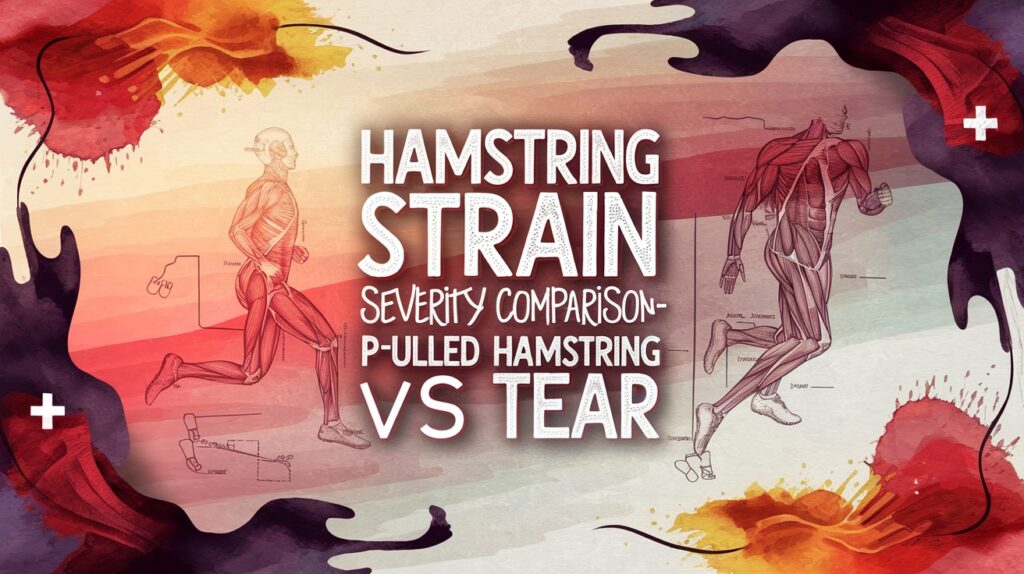When comparing a pulled hamstring to a tear, it’s important to recognize the severity differences. A pulled hamstring, or Grade 1 strain, involves mild overstretching with sudden pain but minimal strength loss. In contrast, a tear (Grades 2 or 3) signifies more severe damage, causing intense pain, swelling, and difficulty moving. Diagnosis typically involves physical examination, while treatment ranges from home care for minor strains to structured rehabilitation for more severe injuries. Understanding these distinctions can aid in effective recovery.
Understanding Hamstring Injuries
When you consider hamstring injuries, it’s vital to understand the distinctions between a pulled hamstring and a tear, as these conditions can considerably affect your recovery and treatment options. A pulled hamstring typically indicates a mild strain (Grade 1), where muscle fibers are overstretched, resulting in sudden pain but minimal impact on strength. In contrast, a hamstring tear, particularly a partial (Grade 2) or complete tear (Grade 3), entails more severe muscle damage, leading to intense pain, swelling, and a significant loss of strength. Symptoms vary; a pulled hamstring may cause tenderness and sudden pain, while a tear often involves a popping sensation and difficulty walking. Accurate assessment by a healthcare professional is essential for proper diagnosis and tailored treatment plans.
Differences Between Pulled Hamstring and Tear
Understanding the differences between a pulled hamstring and a tear is essential for effective injury management. A pulled hamstring typically signifies a mild strain (Grade 1), where muscle fibers are overstretched. In contrast, a tear encompasses more significant damage, ranging from partial (Grade 2) to complete (Grade 3). While symptoms of a pulled hamstring may include sudden pain and tenderness without substantial strength loss, a tear often involves intense pain, swelling, bruising, and potential loss of function. Diagnosis for a pulled hamstring usually requires a physical examination, whereas a tear may need imaging, like an MRI, to evaluate the damage. Treatment approaches also differ; pulled hamstrings often involve R.I.C.E., while tears might necessitate intensive rehabilitation or even surgery.
Symptoms of Pulled Hamstring and Tear
Symptoms of a pulled hamstring and a hamstring tear can markedly differ, impacting how you approach recovery. A pulled hamstring, or mild strain (Grade 1), usually presents sudden pain and tenderness but often allows you to continue moving, albeit with discomfort. In contrast, a hamstring tear (Grades 2 and 3) is marked by increased pain, significant swelling, bruising, and often a popping sensation during the injury. Grade 2 tears involve partial muscle damage, leading to noticeable strength loss, while Grade 3 tears are complete ruptures that can severely impair your mobility. Both conditions may cause muscle spasms, stiffness, and delayed soreness, yet the severity and duration of symptoms are generally greater with a tear, indicating a more serious injury.
Diagnosis and Evaluation Methods
A proper diagnosis and evaluation of a pulled hamstring or tear is essential for effective treatment and recovery. It often starts with a thorough physical examination by a healthcare provider, focusing on tenderness, swelling, and range of motion in the affected area. The severity of the injury is classified into three grades: Grade 1 for mild strains, Grade 2 for partial tears, and Grade 3 for complete tears. To aid in diagnosis, healthcare providers may ask specific questions about the pain’s location, the timing of symptoms, and the activity during the injury. In some cases, imaging tests like MRI are ordered for a detailed evaluation, particularly for suspected Grade 2 or Grade 3 injuries, ensuring timely and accurate diagnosis.
Treatment and Management Strategies
When dealing with a pulled hamstring or a tear, it is essential to implement appropriate treatment and management strategies to facilitate recovery and prevent further injury. For a pulled hamstring, the R.I.C.E. method—rest, ice, compression, and elevation—helps reduce pain and swelling initially. In contrast, managing a hamstring tear involves a more structured rehabilitation approach, often including physical therapy to restore strength and flexibility over weeks. Grade 1 strains may respond well to home treatment, but Grade 2 and 3 injuries typically require medical evaluation and imaging. As you recover, gradually reintroduce activities, focusing on light stretching and strengthening exercises. Following healthcare provider guidelines and avoiding high-intensity activities until full strength returns greatly reduces re-injury risk.
Prevention Techniques for Hamstring Injuries
To effectively prevent hamstring injuries, it is crucial to adopt a thorough approach that includes regular stretching, proper warm-up routines, and strength training. Begin with dynamic stretches before physical activities to prepare your muscles and joints for sudden movements. This reduces the risk of strains during explosive actions. Additionally, gradually increasing the intensity and volume of your training helps your muscles adapt without becoming overstrained. Incorporate strengthening exercises like hamstring curls and deadlifts to enhance muscle resilience and overall leg stability. Finally, maintain a balanced diet rich in nutrients to support muscle recovery and performance. By following these techniques, you can greatly lower your chances of experiencing pulled hamstrings and improve your overall athletic performance.

